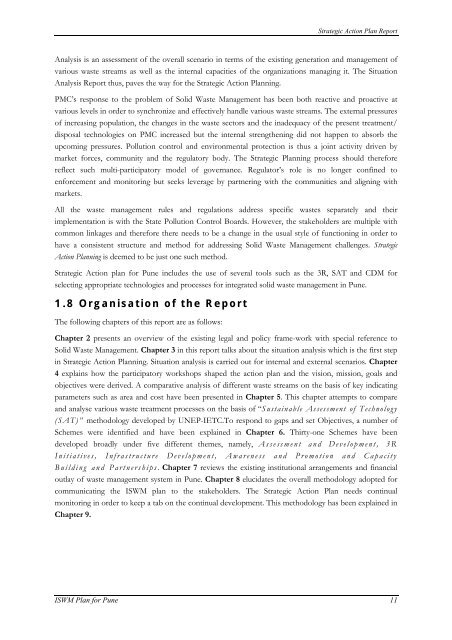Strategic Action Plan - International Environmental Technology Centre
Strategic Action Plan - International Environmental Technology Centre
Strategic Action Plan - International Environmental Technology Centre
Create successful ePaper yourself
Turn your PDF publications into a flip-book with our unique Google optimized e-Paper software.
<strong>Strategic</strong> <strong>Action</strong> <strong>Plan</strong> Report<br />
Analysis is an assessment of the overall scenario in terms of the existing generation and management of<br />
various waste streams as well as the internal capacities of the organizations managing it. The Situation<br />
Analysis Report thus, paves the way for the <strong>Strategic</strong> <strong>Action</strong> <strong>Plan</strong>ning.<br />
PMC’s response to the problem of Solid Waste Management has been both reactive and proactive at<br />
various levels in order to synchronize and effectively handle various waste streams. The external pressures<br />
of increasing population, the changes in the waste sectors and the inadequacy of the present treatment/<br />
disposal technologies on PMC increased but the internal strengthening did not happen to absorb the<br />
upcoming pressures. Pollution control and environmental protection is thus a joint activity driven by<br />
market forces, community and the regulatory body. The <strong>Strategic</strong> <strong>Plan</strong>ning process should therefore<br />
reflect such multi-participatory model of governance. Regulator’s role is no longer confined to<br />
enforcement and monitoring but seeks leverage by partnering with the communities and aligning with<br />
markets.<br />
All the waste management rules and regulations address specific wastes separately and their<br />
implementation is with the State Pollution Control Boards. However, the stakeholders are multiple with<br />
common linkages and therefore there needs to be a change in the usual style of functioning in order to<br />
have a consistent structure and method for addressing Solid Waste Management challenges. <strong>Strategic</strong><br />
<strong>Action</strong> <strong>Plan</strong>ning is deemed to be just one such method.<br />
<strong>Strategic</strong> <strong>Action</strong> plan for Pune includes the use of several tools such as the 3R, SAT and CDM for<br />
selecting appropriate technologies and processes for integrated solid waste management in Pune.<br />
1.8 Organisation of the Report<br />
The following chapters of this report are as follows:<br />
Chapter 2 presents an overview of the existing legal and policy frame-work with special reference to<br />
Solid Waste Management. Chapter 3 in this report talks about the situation analysis which is the first step<br />
in <strong>Strategic</strong> <strong>Action</strong> <strong>Plan</strong>ning. Situation analysis is carried out for internal and external scenarios. Chapter<br />
4 explains how the participatory workshops shaped the action plan and the vision, mission, goals and<br />
objectives were derived. A comparative analysis of different waste streams on the basis of key indicating<br />
parameters such as area and cost have been presented in Chapter 5. This chapter attempts to compare<br />
and analyse various waste treatment processes on the basis of “Sustainable Assessment of <strong>Technology</strong><br />
(SAT)” methodology developed by UNEP-IETC.To respond to gaps and set Objectives, a number of<br />
Schemes were identified and have been explained in Chapter 6. Thirty-one Schemes have been<br />
developed broadly under five different themes, namely, Assessment and Development, 3R<br />
Initiatives, Infrastructure Development, Awareness and Promotion and Capacity<br />
Building and Partnerships. Chapter 7 reviews the existing institutional arrangements and financial<br />
outlay of waste management system in Pune. Chapter 8 elucidates the overall methodology adopted for<br />
communicating the ISWM plan to the stakeholders. The <strong>Strategic</strong> <strong>Action</strong> <strong>Plan</strong> needs continual<br />
monitoring in order to keep a tab on the continual development. This methodology has been explained in<br />
Chapter 9.<br />
ISWM <strong>Plan</strong> for Pune 11
















